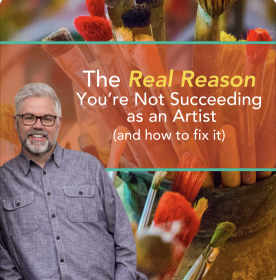Email marketing is one of the most powerful tools for growing your art business. But what happens when people open your emails, read through them, and don’t click the links? Low click-through rates (CTR) can be frustrating, but they’re fixable. With the right strategies, you can encourage your subscribers to engage with your content and take action. Here’s how.
1. Craft a Clear and Compelling Call-to-Action (CTA)
Your CTA is the single most important element to drive clicks. A clear and specific CTA tells your readers exactly what to do and why they should do it.
- Use action words: Start your CTA with verbs like “Download,” “Discover,” “Learn,” or “Get.”
- Focus on benefits: Instead of a generic “Click Here,” use phrases like “Get Your Free Art Pricing Guide” or “See How to Sell More Art Online.”
- Create urgency: Add time-sensitive phrases such as “Limited Time Offer” or “Only Available Today.”
Example:
- Bad: “Click here.”
- Good: “Start Building Your Profitable Art Business Today!”
2. Optimize Link Placement
Strategically positioning your links can significantly boost click rates. Make it easy for readers to find and act on your CTA.
- Place CTAs early: Many readers don’t scroll, so include your primary link near the top of the email.
- Repeat CTAs: Reiterate your link in different sections of the email, such as mid-way and at the end.
- Use buttons: Buttons are visually distinct and tend to get more clicks than plain text links.
3. Personalize Your Emails
When your email feels personal, readers are more likely to engage. Tailoring content to your audience’s interests builds trust and makes them feel seen.
- Use their name: Include the recipient’s name in the subject line or opening sentence.
- Segment your audience: Group your email list by interests, location, or engagement level, and send content tailored to each segment.
- Reference past behavior: Mention their previous interactions, such as attending a workshop or downloading a freebie.
4. Write Engaging Content
If your email isn’t compelling, your readers won’t feel motivated to click. Engage them with short, impactful copy.
- Use storytelling: Share a relatable story or problem that leads naturally to your link.
- Be concise: Get to the point quickly, as long emails can lose attention.
- Highlight the value: Show why clicking the link will solve a problem or meet a need.
5. Make Your Links Stand Out
Your links need to grab attention. Ensure they’re easy to find and visually appealing.
- Use contrasting colors: Make your buttons or links stand out from the email background.
- Bold or underline text links: This draws the reader’s eye to the clickable area.
- Keep link text short: A succinct link like “Learn More” or “See Details” is more inviting than a long URL.
6. Encourage Engagement with Curiosity and Questions
Pique your readers’ curiosity or invite them to participate in a conversation.
- Ask questions: Use questions like, “Are you ready to make your art profitable?” to spark interest.
- Tease valuable content: Use phrases like “The 3 Secrets to Selling Art Online—Find Out #2 Here!”
7. Test and Optimize Your Emails
Continuous improvement is key to email marketing success. Experiment to discover what works best for your audience.
- A/B test elements: Test different subject lines, CTAs, link placements, or email designs.
- Analyze metrics: Use your email platform’s analytics to see which links are getting the most clicks and adjust accordingly.
8. Remove Barriers to Clicking
Make sure there’s nothing in your email or on your landing page that could discourage clicks.
- Simplify the landing page: Ensure your link directs to a page that delivers exactly what you promised.
- Use mobile-friendly design: More than half of emails are opened on mobile devices. Make sure your email and links look great on smaller screens.
- Limit distractions: Focus on one primary CTA per email to avoid confusing or overwhelming readers.
9. Send Emails at the Right Time
Timing can greatly affect engagement. Sending your emails when your audience is most active increases the likelihood of clicks.
- Test send times: Experiment with different days and times to see when your audience is most responsive.
- Avoid email fatigue: Don’t overwhelm your subscribers with too many emails.
Getting more people to click on your email links isn’t magic—it’s strategy. By crafting compelling CTAs, optimizing your links, personalizing your content, and continually testing and improving, you’ll see higher click-through rates and better engagement. Remember, email marketing is a long game. Keep refining your approach, and the clicks will follow.
Ready to start building better emails? Try implementing just one or two of these strategies today, and watch your results improve!



Leave a Reply